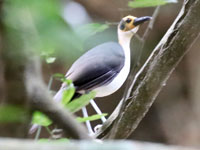The Rockjumpers consist of two African species. There nearest relatives are unknown: perhaps babblers or thrushes.
Genus Chaetops
The rockjumpers forage on rocky terrain and frequently perch on rocks.
Rockjumper, Cape Chaetops frenatus Found: southernmost South Africa
The male Cape Rockjumper has a dark gray upperparts, head; thin white supercilium; broad white moustache; long black tail; rufous red underparts, rump. Female has pale gray instead of dark gray; buff underparts; orange rump.
Similar to: Drakensberg Rockjumper. Male Cape Rockjumper has red underparts; Drakensberg Rockjumper has orange underparts. Female Cape Rockjumper has darker underparts.
Image by: 1) Mathew Wridgway- South Africa 2) Blake Mathewson - South Africa 3) Paul Bernard - South AfricaSimilar to: Drakensberg Rockjumper. Male Cape Rockjumper has red underparts; Drakensberg Rockjumper has orange underparts. Female Cape Rockjumper has darker underparts.
1) Male
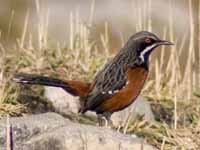
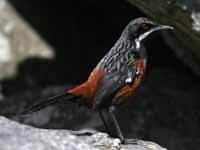
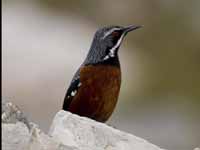
Rockjumper, Drakensberg also Orange-brested Rockjumper Chaetops aurantius Found: Drakensberg Mountains of South Africa
The male Drakensberg Rockjumper has a dark gray upperparts, head; thin white supercilium; broad white moustache; long black tail; orange underparts; rufous rump. Female has pale gray instead of dark gray; buff underparts; orange rump.
Similar to: Cape Rockjumper. Male Cape Rockjumper has red underparts; Drakensberg Rockjumper has orange underparts. Female Cape Rockjumper has darker underparts.
Image by: 1) Donald Macauley 2) Finch-Davies 3) Francesco VeronesiSimilar to: Cape Rockjumper. Male Cape Rockjumper has red underparts; Drakensberg Rockjumper has orange underparts. Female Cape Rockjumper has darker underparts.
1) Female 2, 3) Male
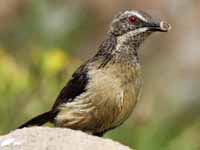
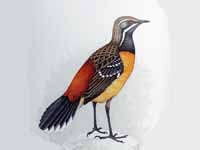
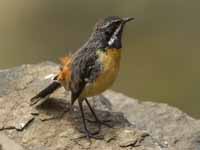
The rockfowl are also termed bald crows. Their closest relatives might be the crows, but the Rail-babbler has also be proposed.
Genus Picathartes
They have unfeathered heads, and feed on insects and invertebrates picked from damp rocky areas. Both species are totally non-migratory, being dependent on a specialised rocky jungle habitat
Rockfowl, Gray-necked Picathartes oreas Found: western Africa
The Gray-necked Rockfowl has gray upperparts; light gray neck,upper-breast; lemon colored rest of underparts; bluish forehead; carmine hind crown; black cheeks.
Image by:
1) Casliber 2) P_Khoo 3) Nik_Borrow - Cameroon 1) Gray-necked location shown in green.
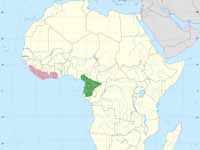
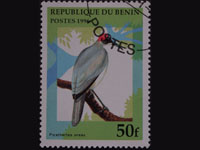
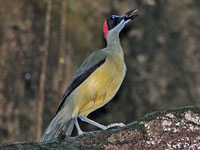
Rockfowl, White-necked Picathartes gymnocephalus Found: western Africa
The White-necked Rockfowl has grayish-black upperparts; white underparts; long brown tail; yellow head with black patches behind eyes.
Image by: 1) Casliber 2) Michael Andersen 3) GrahamC571) White-necked location shown in pink.


